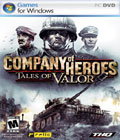Genre: Real-Time Strategy
Publisher: THQ
Developer: Relic
Release Date: April 8, 2009
We recently got to join the development team in checking out the multiplayer component of the upcoming expansion, Company of Heroes: Tales of Valor. While the other expansions have focused on adding armies or units to the title, Tales of Valor will add three new single-player campaigns and three new multiplayer gameplay modes. We were able to play two of these multiplayer modes, and they build upon Company of Heroes in ways that are a little beyond the norm.
Operation: Panzerkreig was the first new mode we tackled, which puts each player in command of one tank of their side. Each side gets three tanks from which to choose: two already established tanks and a new tank to mix things up. Each tank has its own set of upgrades, which are purchased using command points that are acquired as you gain combat experience. These upgrades include passive abilities, such as increased shot damage, and active abilities, such as the ability to charge forward in a burst of speed or conceal yourself to make your first shot more deadly. Next to enemy tanks, you can see how many command points the controlling player has accumulated, so you can tell at a glance whether that Panther is relatively limited in its abilities or if it is bristling with combat options.
Conversely, this number can also put a target on your back, since you gain more experience for killing enemy tanks that are upgraded. When your tank is killed, you keep your upgrades but must wait for it to respawn back at your base, which is an indestructible structure protected with similarly invincible anti-tank guns. Bases are always available to the player as a safe place to retreat to and repair, and instead of being tasked with destroying all of the other side's bases, the objective is to reduce their victory points to zero while avoiding having the same fate happen to your team. Holding control points slowly drains the enemy side of its victory points, while killing an enemy tank deducts victory points immediately.
There are no personnel or fuel resource points to hold; personnel come in at a fixed rate for all players regardless of the battle's status, and fuel simply isn't used. Munitions points are scattered across the map and are mostly used for special tank abilities but can also be utilized for control point-specific abilities. Each control point on the map grants each player on the controlling side with special abilities, such as artillery strikes and mortar bombardments, with the third point upgrading the AI infantry that all players can use. To use the AI infantry, you specify a point on the map and spend the personnel points to have a squad of infantry defend that position. While the bulk of the battle will be between the player tanks, the AI-controlled infantry lets players spend more time engaging in tank combat and less time babysitting points.
The other game mode we played was Operation: Stonewall, which completely caters to fans of the series who enjoy participating in multiplayer battles against computer-controlled opponents. In Stonewall, each of the four players starts off in the middle of the map, with all of the base buildings sitting right next to each other. There are four special buildings on the map to hold, such as a church that will heal nearby infantry, and others that offer differing bonuses. Of course, it is not long before a wave of enemies comes onto the map from a random direction, and the players must respond. Though the first wave is generally easy, the waves get consecutively harder and harder, with only veteran players likely to survive the mode's 16 waves. This mode is meant to be quite difficult at the very end, and even our group, which was mostly comprised of the game developers, ended up getting blasted to bits by the 14th wave.
In this mode, units are unlocked on two linear trees: infantry and vehicles. For instance, the first unit you can unlock is the sniper, which allows you to create snipers and lets you unlock the HMG unit next. Upgrades are incredibly expensive, given the relatively low and fixed rate that resources come in, so generally speaking, it is a good idea for players to communicate what they're going to bring to the table so that they can cover all aspects and not overspend. All units are created from your main base building, so the mode mostly depends on effectively using your units in combat.
The three new single-player campaigns are incredibly short affairs, with each campaign consisting of three sequential missions that take place on their own map. The first campaign follows a German Tiger tank commander as he makes a name for himself on D-Day, the second centers on an American paratrooper squad as it fights to hold a causeway on the day after, and the third focuses on the German defense of a town against a massive number of Allied forces. The campaigns are well done but are short to the point that right when you feel you're getting into the action, they end.
The expansion also adds some new gameplay features to the title, one of which is called Direct Control. It turns your mouse cursor into an aiming reticle for as long as you have the ability active, letting you control movement with the right mouse button while directly aiming and firing the unit's weapon with the left. Snipers, tanks, 88s, and some infantry squads are some of those who make use of this feature, with varying levels of effectiveness. The ability shines when you're using it on tanks and snipers, but against squads of men with SMGs, it sometimes seems more efficient to have the AI take over fire control. When it works, it immerses you in the combat that much more, and it allows for much finer control over aiming and when you can and cannot fire. The units become much more effective than if you had simply left the tasks to the AI.
Company of Heroes: Tales of Valor is a different sort of expansion, as it really doesn't bring a whole lot of new content to the table in the form of the single-player experience. The expansion is centered on the new multiplayer modes and some new features, with a few new units added in for good measure. Direct Control mixes up how you think about controlling your units quite a bit, but the Operations multiplayer modes really throw your gameplay experience for a loop and let multiplayer participants go to war in ways much different than the series norm. Keep an eye on our continued coverage of Tales of Valor as it gets closer to its release date.
More articles about Company of Heroes: Tales of Valor










 Featuring three intense campaigns, brand-new multiplayer modes and an innovative direct-fire feature that allows even more tactical control during the heat of battle, Company of Heroes: Tales of Valor will immerse players in some of the most historic, tide-turning clashes of World War II.
Featuring three intense campaigns, brand-new multiplayer modes and an innovative direct-fire feature that allows even more tactical control during the heat of battle, Company of Heroes: Tales of Valor will immerse players in some of the most historic, tide-turning clashes of World War II.


































